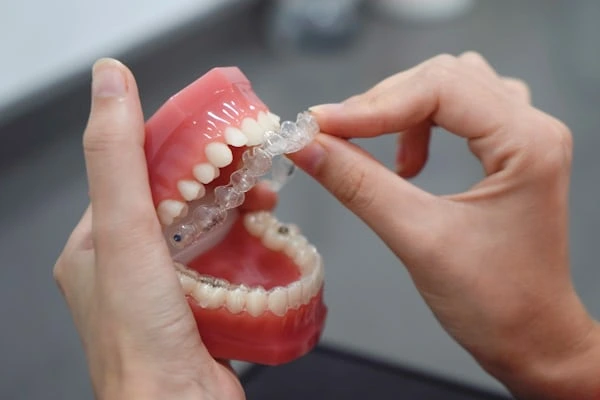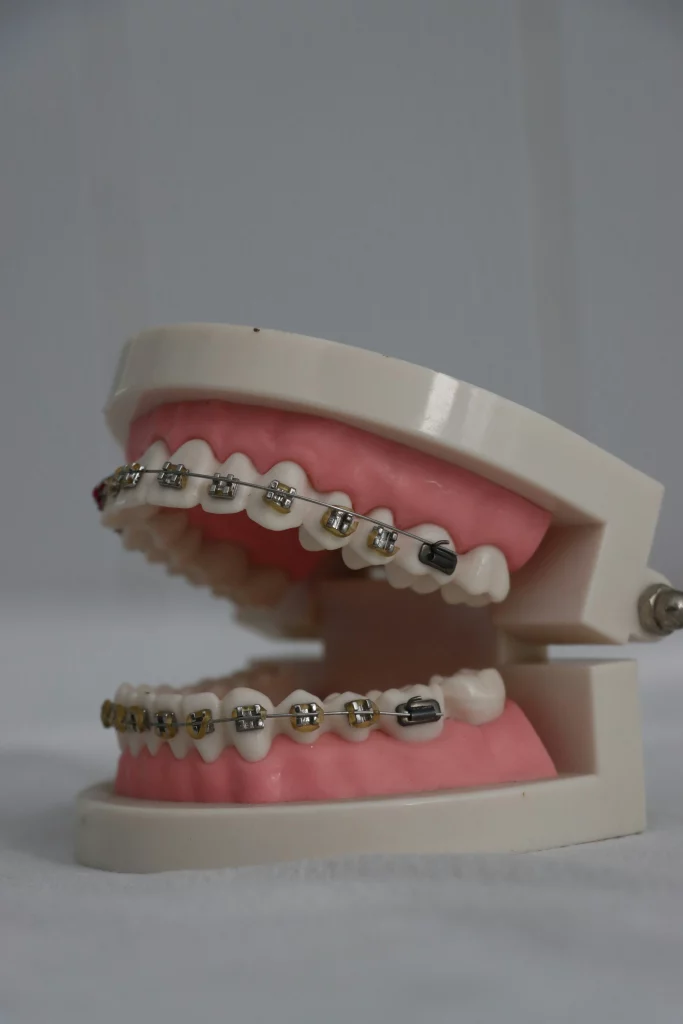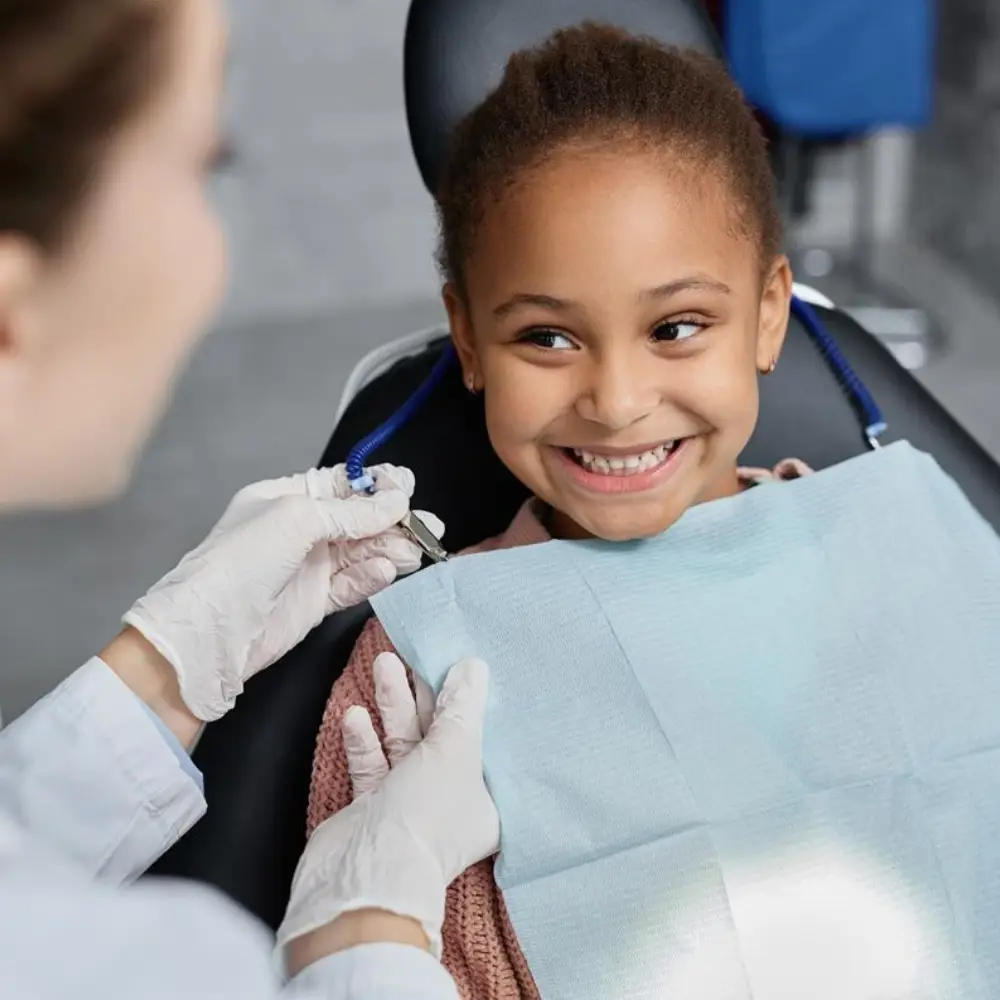The most famous thing about Invisalign is that it enables the straightening of teeth in a discrete way, yet it can also lead to better speech. Crowded, gapped or misaligned teeth may influence the manner in which the tongue and lips shape some sounds and in some cases words may become more difficult to articulate. Invisalign can straighten teeth to help you improve your smile and achieve clear speech patterns by slowly positioning the teeth into a more favorable position.
This will be a blessing to many as far as they are bound to communicate better, feel confident and have few frustrations during the day to day conversations. Straight teeth are not just pretty, they can also assist in making you sound better.
How Invisalign Can Help with Speech Issues

Usually, Invisalign is selected due to its aesthetic value and comfort, yet most individuals are unaware of the fact that it can also be helpful in enhancing speech clarity. The placement of your teeth and jaws also has a direct impact on the movement of your tongue as well as the flow of air as you shape words. Crooked, crowded, or far spacing of teeth may interfere with this natural movement, and some sounds, particularly sharp consonants or mixtures of syllables, may be harder to articulate.
This may in the long run cause frustration or self-consciousness in speech. Invisalign removes these obstacles and forms a more balanced oral structure by softly pivoting the teeth to the right position. Not only does this increase confidence in day-to-day conversations, but also makes speech therapy sessions more fruitful, which makes progress attainable with less difficulty.
Misaligned Teeth and Their Impact on Pronunciation
Out of place teeth may block or divert airflow in a manner that interferes with normal speech. As an example, tooth gaps tend to produce a faint whistle when saying s or z words, and crowding may make the tongue less able to move freely around the mouth. Due to the fact that correct pronunciation requires correct positioning of the tongue and the flow of air, even minor displacement may result in evident speech problems.
Invisalign is effective by slowly moving the teeth to a healthier and more natural position, which not only makes them look better but also to reestablish the space and balance required to articulate properly. The better the alignment, the more effective the functioning of the tongue, the speech sound becomes clearer and more natural.
Common Speech Sounds Affected by Malocclusion
Children and adults with malocclusion often struggle with “s,” “sh,” “z,” and “th” sounds. These require fine control of airflow and tongue placement against or between the teeth. Misalignment can distort these sounds, sometimes creating lisps or unclear enunciation. By improving alignment, Invisalign helps establish the physical foundation needed for crisp, accurate pronunciation.
Why Orthodontic Alignment Supports Speech Therapy Goals
Speech therapists usually indicate that structural problems with teeth or jaw configuration can inhibit the extent to which the patient can achieve in a realistic sense. With practice and great effort, still some sounds might be inaccessible when there is not enough room or support to aid the movement of the tongue. Invisalign can help in this. Through the progressive correction of the misalignments, it offers a non-invasive method of establishing a healthier base on which to produce speech. As their teeth are moving into improved positions, patients are able to continue their therapy, and both therapists and patients have a better opportunity to realize clear and permanent change in speech.
Invisalign vs. Braces in Speech Correction

Conventional braces have always been the standard in orthodontic care, but due to their large size and the use of metal bracket, they sometimes can hamper speech and delay treatment. They can result in additional friction, restrict the movement of the tongue, or produce temporary speech problems as a patient adapts. Instead, invisalign is a more discrete and comfortable alternative. Its removable aligners are smooth, allowing the patient to keep in speech therapy without as much disruption, a combination of orthodontic effectiveness and comfort in daily life.
Does Invisalign Cause a Lisp or Help Reduce One?
It is normal to have a small lisp when the new Invisalign wears are speaking, and the sounds with a slight lisp occur when they are saying s and sh. This is because the tongue is adapting to the thin coat of plastic which coats the teeth. Luckily, this adjustment time is generally a short one and in a few days of regular wear most individuals regain their usual speech.
Over time, Invisalign may even prevent or even correct lisps that may be caused by poorly aligned teeth because the aligners will slowly move them into new positions. Although the first change can be inconvenient, the short term lisp can be compensated by long term benefits of clarity, pronunciation and general confidence to speak.
How Invisalign’s Design Affects Tongue Placement
In contrast to the conventional braces, which are based on the use of brackets and wires, Invisalign aligners are smooth and transparent and tailored to fit each patient with their teeth. This smooth design reduces irritation, and minimizes the type of interference that will disrupt the tongue movement. The tongue is able to find a more natural position with less barriers in the mouth and this is critical in clear pronunciation. The more the aligners move the teeth into a better place, the extra freedom and ability to articulate the tongue has. This comfort/correction combination, over time, does not only enhance oral functionality; it also helps to make speech clearer and more confident.
Why Adults Prefer Invisalign for Discreet Speech Treatment
Adults in the workplace or social life usually feel embarrassed with the use of traditional braces, more so when they have to interact more often due to their work or social life. The almost invisible nature of Invisalign offers a less noticeable option so that people can fix alignment and speech problems without the focus on their treatment.
This non-obtrusive strategy is especially useful to individuals in a communication intensive profession- teachers, lawyers, or broadcasters- where clarity and confidence are critical. With equal effectiveness in orthodontic treatment and aesthetics, Invisalign simplifies the process of allowing the adult to focus on their image and oral health.
Working with a Speech Therapist and Invisalign Provider
A combination of orthodontic treatment and speech therapy is usually the best way to treat speech challenges. Whereas, the orthodontic treatment, including Invisalign, addresses the structural problems that influence the positioning of the tongue and the airflow, speech therapy aims at building the articulation and communication abilities. A combination of these strategies will produce a holistic intervention that addresses both physical and functional development of speech. It is worthwhile to have orthodontists and speech therapists collaborate so that patients will achieve gradual gains in alignment as well as confidence in their capacity to do so with clear speech.
Collaborative Approach to Speech and Orthodontic Care
There is an opportunity to have dentists and speech therapists collaborate to assess the effects of dental alignment on the speech patterns. Through their joint experience, they will be able to determine whether the difficulty encountered in pronunciation is of structural or functional nature or both. In this cooperation, they are able to develop a treatment program that does not only fix the alignment, but also develops the articulation skills. This integrated approach is beneficial to patients, and it can be seen that patients experience quicker, more lasting improvements in their oral health and communication.
Timing Orthodontic Treatment with Speech Therapy Milestones
Invisalign may be initiated in the case of speech therapy and it can help greatly, yet timing is a significant factor. In the case of children and teens, orthodontists usually advise the waiting period until some of the permanent teeth have erupted fully to be sure of the effectiveness of the treatment. Adults, in turn, can probably start immediately provided that their oral health is not compromised and does not have complications such as gum disease. Aligners can also be incorporated into speech therapy sessions with the articulation of the patients being practiced with and without the trays. This two-fold method assists the tongue to adjust faster and the therapy process proceeds without break.
Choosing a Dentist Who Understands Speech-Sensitive Treatment
Not all orthodontists have the same emphasis on the speech results, that is why it is so significant to select the appropriate professional. Aligner plans can be crafted by an experienced orthodontist or dentist who has experience with patients who have communication issues to consider both bite correction and articulation. This two-pronged approach will not only prevent the straightening of teeth, but it also will help achieve long-term objectives of having clearer and more confident speech. By integrating orthodontic therapy with the goals of speech therapy, patients are offered a more holistic approach and care that covers both shape and function.
Who Can Benefit from Invisalign for Speech Concerns?
There is no age group or lifestyle to which speech-related challenges are confined. As their teeth and jaws grow, children can have problems with pronunciation, and adults can have persistent problems of alignment that can influence clarity and confidence. Misaligned teeth can be particularly problematic to multilingual speakers, who have to use accurate pronunciation in various languages. The Invisalign provides a flexible solution to all these groups, and it assists to enhance the alignment in a manner that facilitates better communication and easier speech.
Children Struggling with S, Z, or TH Sounds
Difficulties in some sounds are common with normal speech development in children, and misalignment of the teeth can make their problems worse. Curved or overcrowded teeth can disrupt the position of the tongue and create problems with such sounds as s, r, th. Invisalign can help to achieve the structural support required in the articulation of a clear and more natural speech with the help of professional speech therapy. With time, parents can see not only that child has improved speech, but also that he or she has developed more confidence because it is easier to communicate with the world and attend school.
Adults in Public Speaking or Communication Careers
In adults presenting, teaching or working with clients on a regular basis, the speech may not be as clear as it can seem like a major professional impediment. Invisalign is not only effective in improving alignment in a discreet manner but also in improving speech clarity in the long run. This is particularly useful to those professionals whose livelihood is reliant on persuasion, credibility and accuracy of delivery.
Multilingual Speakers Seeking Clearer Enunciation
The multilingual speakers have several special problems because various languages require different tongue positions and the coordination of various muscles. The slightest misfit between the teeth or the jaw may disrupt these adjustments and result in vague sounds or extra effort in changing languages. Invisalign also assists in the formation of consistency in the tongue space and alignment so that one is able to change between languages with ease with more clarity, confidence and less distortion.
Frequently Asked Questions (FAQs)
1. Can Invisalign help with speech problems caused by crooked teeth?
Crooked teeth often interfere with airflow and tongue placement, which can distort certain sounds and make speaking less clear. These challenges may be especially noticeable when trying to pronounce sharper consonants or more complex word patterns. Invisalign works by gradually realigning the teeth, reducing these obstacles and giving the tongue more freedom to move naturally. As alignment improves, speech clarity often follows, allowing words to flow more easily. Many patients also report improvements in overall comfort, since a balanced bite reduces tension and strain in the mouth. Over time, these combined benefits can boost both communication and confidence.
2. Will Invisalign affect my speech negatively at first?
It’s common to experience a slight lisp or difficulty with “s” sounds during the first few days of wearing aligners. This happens because your tongue is adjusting to the new shape and position of the aligners inside your mouth. The good news is that this phase is temporary, and most patients adapt surprisingly quickly. Within a week or two, speech usually returns to normal, often even clearer than before. As the teeth continue to shift into better alignment, articulation becomes easier and more natural. With consistent wear, many people find their overall confidence in communication steadily improves.
3. Is Invisalign a good choice for children in speech therapy?
In many cases, yes. Invisalign can complement speech therapy by addressing the structural challenges caused by malocclusion, which often interfere with proper articulation. For children, however, readiness is an important factor. Since aligners must be worn consistently to be effective, children need to be responsible and committed to following instructions. This is where parental guidance plays a crucial role in ensuring proper wear and care. A dentist and speech therapist can work together to evaluate whether a child is ready for Invisalign, creating a treatment plan that supports both oral health and communication goals.
4. How soon will I notice speech improvements with aligners?
Speech improvements vary by individual and depend on the complexity of their alignment issues. Some patients notice clearer pronunciation within just a few weeks, while others experience gradual changes over several months as their teeth continue to shift into better positions. Progress is often faster when aligner treatment is paired with targeted speech therapy, since both address structural and functional aspects of speech. Consistency plays the biggest role—aligners must be worn as directed, and speech exercises should be practiced regularly. With patience and commitment, many patients achieve lasting improvements in clarity, articulation, and confidence.
5. Can I wear Invisalign during speech therapy sessions?
Yes, and it’s often encouraged to practice speech while wearing Invisalign aligners. Speaking with them in place helps the tongue and mouth adapt more quickly to their presence. Since Invisalign is removable, some therapists may also recommend practicing both with and without the aligners to build flexibility. This dual approach allows patients to adjust faster and maintain clarity in any setting. Over time, consistent practice with the aligners helps reduce lisps and strengthens articulation. Many patients find that this speeds up both adaptation and long-term speech improvement.
Call to Action
If speech clarity has been a lifelong challenge or you’ve noticed pronunciation issues tied to your teeth, Invisalign may be a solution worth exploring. Aligners not only improve your smile but can also create the conditions needed for clearer, more confident communication.
Schedule a consultation with a Graham Park Dental who understands the connection between orthodontics and speech. Together with a speech therapist, they can create a plan tailored to your unique needs. Clearer words, a brighter smile, and renewed confidence could be closer than you think.


